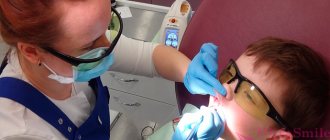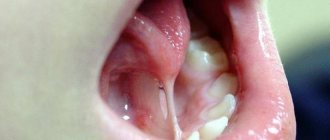.
A tiny patch of skin under the tongue can sometimes cause a lot of problems and worries. We are talking about a frenulum that is attached under the tongue. The pronunciation and clarity of speech, as well as comfort when eating, depend on its location, length and elasticity. This delicate membrane can quickly regenerate, but you should not neglect timely treatment measures if you receive an injury to the frenulum of the tongue.
The frenulum of the tongue is responsible for its movement. Shortened frenulum - pronunciation defects
A little about the complexities of the anatomy of the tongue
The frenulum of the tongue is a thin bridge that connects the lower part of the oral cavity to the tongue. Its main function is to maintain the correct position of the tongue in the mouth by ensuring its movement, which is directly related to diction and the ability to pronounce individual sounds.
To see the frenulum, it will be enough to lift the tongue upward. It is located in the middle of the tongue, connecting to the base of the gums, as if holding this organ in place.
A normal frenulum does not cause discomfort
The length of the frenulum of an adult is approximately 3 cm. If this figure is less or the frenulum of the tongue is located in such a way that when it is raised, it is strongly stretched, we can talk about a short frenulum. In turn, it will interfere with the free rotation, protrusion and elevation of the tongue.
Short frenulum of the tongue - what is it?
But let's look at the problem in more detail. So, short frenulum of the tongue - what is it? The bridge connecting the tongue to the palate, or simply a special ligament if not long enough, significantly reduces the mobility of the tongue. It would seem that this is a trifle. However, children with this problem very clearly suffer from inconvenience. Moreover, it gets worse with age. When baby teeth are replaced by permanent ones, a short frenulum will not allow the dentition to form correctly, which almost always carries a high risk of caries, gum disease and other unpleasant problems.
There are 5 different types of pathology, each of which brings specific discomfort to the child’s life:
- thin and transparent - limits the mobility of the tongue;
- thin and translucent - causes a semblance of bifurcation of the tip of the tongue when directed upward;
- thick - limits the mobility of the tongue;
- dense and very short, combined with the muscles of the tongue - along with cleft lips and palate;
- dense and very short, combined with the muscles of the tongue, severely limits the mobility of the tongue.
The next question naturally arises: who to turn to? If the baby is unable to stick out his tongue or reach his upper teeth, we can conclude that there is a possibility of pathology. However, the final verdict must be made by a professional. The specialist who will make the appropriate diagnosis must conduct an examination of the oral cavity. Most often this is a dentist, but doctors of other specializations can also evaluate the elasticity and length of the frenulum, the normal value of which is 8 mm for 5 years of age.
Most often, a short frenulum is a congenital pathology, including hereditary. The cause of the defect in the child can be viral diseases, stress, toxicosis or other factors during the mother’s pregnancy. It is important to understand that even in the absence of obvious discomfort, trimming is necessary to eliminate the risk of problems in the future.
How to fix the problem and who to contact? The decision on the length of the tongue frenulum is made by parents during a consultation with a dentist. The defect can be eliminated surgically or with the help of special gymnastic exercises for articulation.
The method of eliminating the defect is selected by the dentist individually depending on parameters such as the degree of shortening, the presence of consequences, localization, and the age of the child.
Which method is suitable in your case depends on the surrounding circumstances. So, if a short frenulum is discovered in the first days of a child’s life and directly affects his nutrition, surgery on the frenulum of the tongue is necessary, which is often performed right in the maternity hospital. Please note that for newborns the process will be completely painless! It is also worth operating if an incorrect bite is formed or has formed. After frenuloplasty, the child will experience some discomfort associated with a change in diction. This is a temporary phenomenon that can be easily eliminated by classes with a speech therapist and special gymnastics for the tongue.
If a child has a burr, speech therapy disorders associated with pronunciation and speech can be corrected by performing a set of exercises to develop and stretch the frenulum.
Why does the frenulum hurt?
Tongue diseases are a fairly common problem, but most often quickly solved. The main thing is to choose the right treatment by contacting an experienced specialist.
The mucous membrane under the tongue is highly sensitive; therefore, it can become inflamed and painful even in those people who have never experienced problems with it. It reacts to all kinds of irritants and is also easily damaged.
An abnormal frenulum is injured more often
Causes of pain in the frenulum of the tongue:
| Mechanical injury | When eating solid food or using sharp instruments, there is a possibility of damage to the mucous membrane. |
| Inflammation of the lymph nodes | A number of infectious diseases can lead to inflammation of the submandibular lymph nodes, which will be expressed by pain symptoms in the area of the mucous membranes of the mouth. |
| Allergic reactions | Allergies can be caused by medications, personal care products (toothpaste, mouth rinses) or food products, and the body's reaction will be pain. |
| Overload of the speech apparatus | Loud screams, prolonged conversations and singing can cause an unpleasant feeling of soreness in the frenulum. |
Quite often, pain in the tongue can be echoes of problems in various human organs - the esophagus, teeth and salivary glands.
A lack of vitamins and minerals provokes the development of anemia, a lack of nutrients and B vitamins can also negatively affect the health of the oral mucosa.
An abscess near the frenulum can lead to injury
One of the key rules for pain in the frenulum is not to ignore these painful sensations, because the delicate and sensitive tissues under the tongue perform functions necessary for the body. And it is always easier to prevent a disease than to deal with its consequences and complications.
Short frenulum of the tongue in a child
The lingual frenulum is a fold of the oral mucosa that connects the floor of the mouth to the undersurface of the tongue. The frenulum of the tongue performs a very important function - it fixes the tongue to the soft tissues of the oral cavity, preventing tongue retraction.
Normally, the frenulum stretches from the middle of the lower surface of the tongue, but in some cases the structure of the frenulum is disrupted, thereby shortening it, that is, the upper end of the frenulum is not in the middle, but at the tip of the tongue. Anomaly of the frenulum of the tongue requires observation and even treatment.
You can see a shortened frenulum of the tongue with the naked eye; the following signs indicate it:
- low mobility of the tongue (the child cannot lift the tongue or stick it out);
- bifurcation of the tip of the tongue (a short frenulum pulls the tip of the tongue);
- difficulty feeding in infancy (the baby cannot properly latch onto the mother's nipple or bottle).
Untimely treatment of a shortened frenulum can lead to many consequences, the main ones being:
- the formation of unclear speech, difficulties begin when pronouncing sounds;
- deformation of the lower teeth and lower jaw;
- spaces between teeth;
- malocclusion.
It is recommended to trim the frenulum of the tongue for a child from birth to one year. As a rule, the problem of a short frenulum of the tongue should be noticed in the maternity hospital during the examination of a newborn, when it is much easier to trim it than at an older age. But this does not always become noticeable to the surgeon immediately, so the problem appears already in preschool age, when the child begins to have a clear deviation in speech.
The operation to cut the short frenulum of the tongue should be performed by a dentist. There are several different types of surgery, depending on the age of the child and each specific case:
For babies.
The most suitable age for correcting a frenulum is from 0 to 9 months; it is during this period that the frenulum does not have nerve endings, which makes it easier to carry out the procedure without anesthesia. As a rule, babies undergo a frenotomy - they cut across the skin fold with scissors or a scalpel. In this case, no stitches are required.
For children from 9 months to 5-6 years.
After 9 months, the frenulum thickens, so surgery will require painkillers and possible sutures.
For school-age children and teenagers.
Surgery for older children is more complex as it requires local anesthesia and stitches. After a couple of weeks, the stitches are removed. The postoperative period requires some diet to restore the sutures.
Today, cutting the frenulum of the tongue with a laser has become popular; the procedure takes only one step and does not cause any discomfort. Only a specialist can assess which method of operation will be needed in each specific case.
Causes of frenulum rupture
Life is filled with different situations in which you can break the frenulum of the tongue. This often happens as a result of:
- injuries - for example, from a fall;
- impact - hitting your face can cause injury to the frenulum;
- sudden movement of the tongue.
If there is a small tear in the frenulum, there is no need to panic; it will go away on its own after some time. If the gap is deep, you need to contact your dentist, who will tell you how to relieve the pain and, if necessary, prescribe treatment.
Severe injuries may require surgery.
When and how to trim the short frenulum of the tongue?
Although there is no general consensus, there is often a reluctance to prescribe surgical correction. As a result, a child may receive speech therapy help for years without any visible effect until the shortened frenulum of the tongue is corrected. But examination of structural defects of the frenulum should be a prerequisite for making a differential diagnosis. And surgical correction always precedes the start of speech therapy classes.
Surgical options
There are four ways to correct a tongue frenulum:
- Trimming the frenulum in a newborn.
- Surgery after 6 months of age (frenotomy, frenectomy, frenuloplasty) under general anesthesia.
- Electrocoagulation of the frenulum under local anesthesia.
- Laser frenuloplasty under local anesthesia.
All these methods are successfully used for one or another indication.
Trimming the frenulum of a newborn
This method has a long history. Midwives cut the frenulum of a newborn with sucking problems as early as 1697. Today, dental surgeons have taken on this role. Relieving excess tension on the frenulum of the tongue often leads to an immediate improvement in sucking and eliminates the mother’s discomfort from improper latching on the breast during feeding.
For a child, this procedure is devoid of discomfort and is practically bloodless. It is carried out during the first month after birth, when the nerve endings and blood vessels have not yet grown into the fold of the frenulum.
Advantages: If the only purpose of the operation is to facilitate the process of breastfeeding, then the operation effectively fulfills its role. It is quick, painless and without the use of anesthesia.
Disadvantages: there are situations when there is shortening of not only the frenulum cord, but also the hyoid muscle. In this case, tongue mobility will not be able to meet the child’s growing needs for speech development. And you have to repeat the frenuloplasty operation at a later age.
Surgery under general anesthesia
From the age of 6 months. children can already tolerate anesthesia and this allows for the classic operation of frenotomy, frenectomy or vestibuloplasty.
Advantages: the use of anesthesia allows the child to relax and not interfere with the operation process. This ensures safe work around large vessels in the sublingual area.
Disadvantages: long healing period and accompanying difficulties in eating and talking.
Increased tongue mobility requires new coordination skills. As a rule, 10 days after surgery it is recommended to start classes with a speech therapist.
Electrocoagulation
Proponents of this technique suggest its use in cases of moderate shortening of the frenulum of the tongue. When there are no large vessels in the frenulum fold and its size is small. The method is quite economical and safe if used by experienced specialists. It is performed under local anesthesia.
Laser surgery
A relatively new and most advanced type of operation, available to both newborns, older children and adults. It can be performed exclusively under local anesthesia. The procedure only takes a couple of minutes, but requires a certain degree of cooperation from the child.
Advantages: no bleeding, pain or risk of infection; rapid healing (sometimes within a few hours); You can continue classes with a speech therapist after 2 days.
Repeated intervention: rarely there are cases of severe shortening of the frenulum of the tongue. In such situations, one operation may not be enough. Subsequent interventions lead to the restoration of full tongue mobility.
What to do if the frenulum is torn under the tongue
Injury and rupture of the frenulum can occur when its length is limited and there is insufficient elasticity. Getting this injury is not so easy, but it is possible when using sharp instruments or falling.
There is a certain list of actions that must be followed in order for this injury to pass without consequences for the body.
An injured frenulum definitely requires treatment
Rinse your mouth. Just clean, preferably cold water will do. If there is bleeding, the mouth should be rinsed with an antiseptic solution. This could be hydrogen peroxide, furatsilin, chlorophyllipt or maraslavin. You can also make a solution using baking soda, at the rate of 1 teaspoon of soda per glass of water.
To reduce pain, cotton swabs soaked in a lidocaine solution will help. Simply apply a tampon to the site of injury and the pain will noticeably decrease after a short period of time.
Minimize the load on the speech apparatus until complete healing.
To avoid re-rupture and microcracks, it is better to remain calm during the healing period.
Furacilin for rinsing is an effective remedy
Avoid consuming too hot or cold foods, as well as dry and rough foods. In the daily menu, it is better to use dishes with a liquid consistency, soft, not hot foods.
Surgical suturing of an injured frenulum
Local antiseptics are useful - trachysan, furatsilin, etc. The form of action is convenient for you: lollipops, spray, solution.
By taking a course of vitamins, recovery will be faster. It is recommended to adhere to the rules of personal hygiene; it is better not to touch the rupture site with your hands or apply pressure.
If the rupture site does not heal for a long time and causes discomfort, you should consult a doctor.
Surgical treatment of an injured lower frenulum
An experienced specialist will help relieve pain and prescribe, if necessary, adequate treatment.
Laser treatment - modern technology
Help from traditional medicine
Using folk recipes and solutions, you can disinfect wounds without resorting to pharmaceuticals. In addition, many of them promote rapid healing of wounds and reduce pain.
Sage tincture. An excellent assistant in the fight against pain during the treatment of various oral injuries. To obtain a miraculous decoction, you need 2 tbsp. pour sage with 2 cups of boiling water and leave for about half an hour. You can rinse 5-10 times a day or as needed.
Sage tincture for rinsing - an effective folk remedy
Chamomile tincture. Chamomile has long been known for its antimicrobial properties. 1 tbsp of dried flowers of this plant is poured with boiling water and infused for 30-40 minutes. The broth must be filtered and used as a rinse solution several times a day.
Bedstraw decoction. This decoction can be used as a tea or rinse. Pour a tablespoon of herb into 1 cup of boiling water and leave for at least 30 minutes.
Alcohol tincture of St. John's wort. It is necessary to prepare 5 parts of 40% alcohol and 1 part of dried St. John's wort herb, let it brew for a while. After this, use 25-30 drops of tincture per glass of water and rinse. This is an excellent remedy for injuries to the tongue and oral cavity.
Using folk recipes, you can save a lot, and the result sometimes exceeds all expectations.








